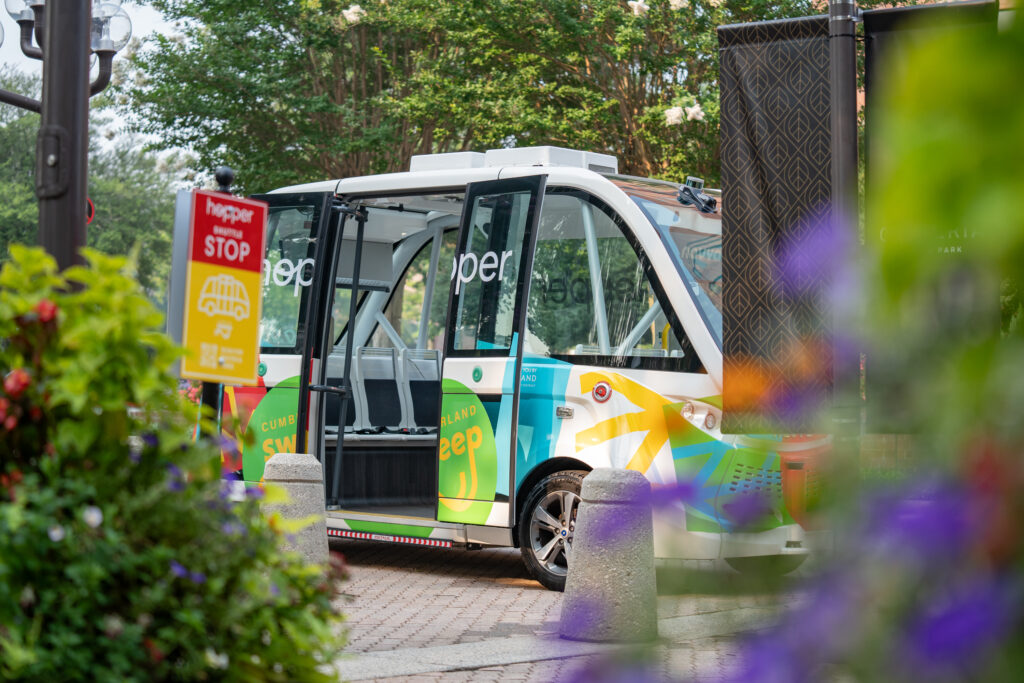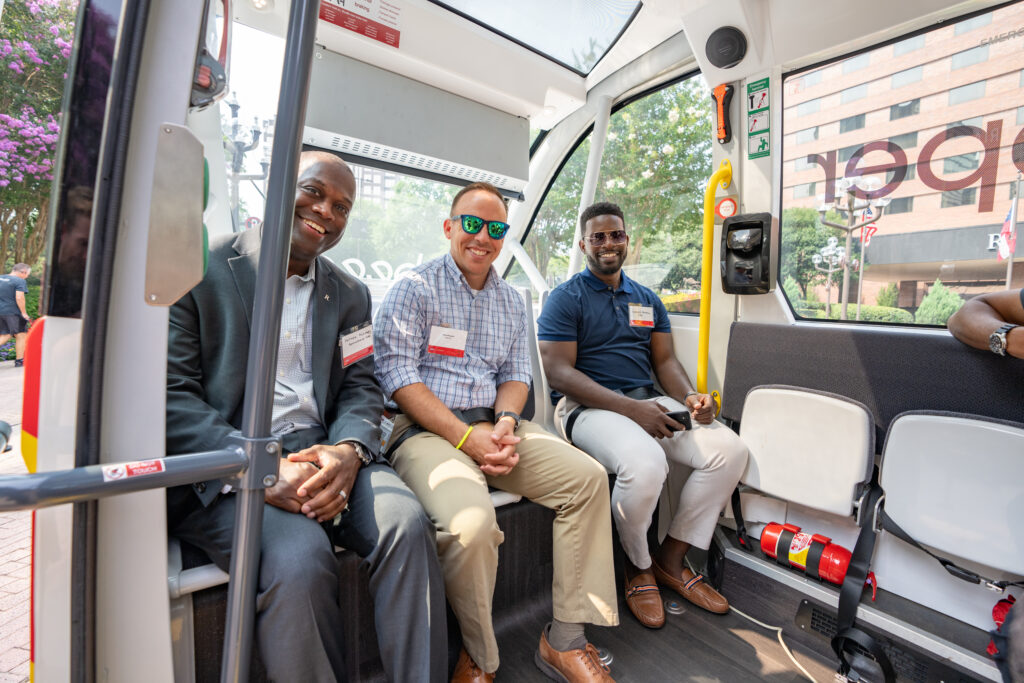


Frequently Asked Questions
Beep delivers the next generation of mobility services utilizing driverless, electric, multi-passenger vehicles. By specializing in planning, deploying and managing advanced autonomous shuttles for both private and public communities, Beep safely connects people, places and services in first-mile, last-mile mobility networks. Beep also leverages the data and learnings from its public road deployments to produce vehicle agnostic, edge solutions meant to enhance safety, access, artificial-intelligence and driverless operating capabilities of autonomous platforms. Beep delivers on a primary goal of enabling mobility-for-all with the services and software they provide. Beep has planned, managed and deployed autonomous shuttles across 6 states and more than two dozen communities across the country including Florida, Georgia, North Carolina, Arizona, California and Yellowstone National Park. For more information visit: www.ridebeep.com
Prior to deployment, Beep creates a high resolution, multi-dimensional map of the shuttle’s routes. On the roadway, a variety of technologies such as traditional navigation sensors, GPS, and LiDAR enable the shuttle to understand where it is in the world, comparing what the shuttle “sees” in real time to what it expects to “see” based on the high resolution map loaded into the shuttle. As the shuttle proceeds along route, additional sensors such as radars and LiDARs are used to detect any obstacles in its path, such as pedestrians or other vehicles, enabling the vehicle to make decisions on how to proceed along its route.
Each one of Beep’s autonomous shuttles routes receives approval from the federal government. The National Highway Traffic Safety Administration (NHTSA) knows where the shuttles will be operating and during what times of the day.
The shuttles can travel up to 15 mph along the corridor and have varying speeds based on where autonomous shuttle is along the route.
Several factors impact the speed of the vehicle. Our vehicles are best suited for controlled speed, geo-fenced environments. Typically, those environments are high density mixed traffic, and pedestrian and cyclist rich. The shuttle will respond to what it “sees” and acts quickly to avoid anything in the shuttle’s path, causing the vehicle to slow or even stop. The speeds are programmed to ensure a safe and pleasant experience for passengers and those that interact with it.
Autonomous shuttles will share the road with buses and other vehicles during operational hours. Similar to transit buses and traditional vehicles, the shuttle will observe all traffic signals, stop signs, and rules of the road. The shuttle attendant onboard will also do a visual check of the intersection before entering to ensure the vehicle’s safe operation. There are various optical sensors on the outside of the shuttle, providing a 360-degree view of the environment. Each sensor allows the shuttle to respond to traffic or pedestrians that may come in the vehicle’s path.
Safety is accounted for at many different levels for a project; including where, how and when the shuttle operates and how it will be monitored. Safety touches every aspect of a project from the planning, implementation of systems and vehicle selection for the project.
Beep works alongside each of its partners to select and evaluate the best area for a project to ensure the autonomous shuttle will operate optimally and safely. Beep also trains first responders to ensure they are familiar with where the shuttle will be operating, how it will operate and how it will be monitored by our staff on the ground and remotely through our Beep Command Center. During first responder training, Beep staff provids first responders an overview of its safety response plan and the safety features on the shuttle including how to access the shuttle in the event of an emergency.
During the project, Beep will have continuous monitoring and oversight of the operations both on the ground and remotely through our Beep Command Center in Orlando. The shuttle attendant onboard will serve as an ambassador for the technology and project while also providing on the ground and in vehicle support should a need arise for passengers onboard. Our Beep Command Center will also monitor the shuttle’s operation; including battery percentage, vehicle telemetry data and pinpoint location of the vehicle. Our Beep Command Center will know where the vehicle is at all times and how it’s performing on route to ensure rider safety and experience is paramount.
The autonomous shuttle is equipped with seatbelts, an onboard emergency kit, and an emergency stop button. The autonomous shuttle is always communicating with the Beep Command Center through interior cameras and GPS locators that monitor the shuttles movement and location at all times. A shuttle attendant will always be onboard to ensure the safety and comfort of its passengers.
The shuttle attendants have been fully trained on the safety features of the vehicle. The Beep Command Center support engineers are also trained on how to respond to an emergency should the shuttle attendant need assistance. Beep will always conduct safety training with First Responders, such police and fire, to familiarize First Responders with the scope of the project, incident response plan, and shuttle capabilities and emergency features.
The autonomous shuttle and the shuttle attendant are in constant communication with the Beep Command Center located in Orlando, Florida. The personnel in the Beep Command Center continuously monitor the autonomous shuttle’s movement and operations. The shuttle attendant can communicate with the command center at any time should the need arise. The autonomous shuttle is equipped with cameras so that the command center can see outside and inside at any time.
How to ride the autonomous shuttles:
The autonomous shuttle will have a number of pre-defined stops along its route. Passengers who want to ride the shuttle can board the shuttle at any one of those shuttle stop locations on route. Once passengers get onboard, they are required to remain seated at all times and wear a seatbelt.
The autonomous shuttle can transport up to 8 passengers. Passengers are required to wear a seatbelt at all times while the vehicle is in motion.
The shuttle attendant will always be onboard while it is operational, ensuring a pleasant and safe experience for our passengers. Our team of shuttle attendants are highly trained to provide prompt and efficient transportation for all our guests. They are also trained on the autonomous shuttle’s safety features. The shuttle attendant can take over manually at any time by utilizing a controller on board. They are also very friendly and would love to share more with you about the area, the attractions, and the service. Shuttle attendants are meant to serve as ambassadors for the autonomous shuttle and educate riders on how the shuttle operates.
It is free to ride. Passengers are limited to one consecutive round trip.
The autonomous shuttle has several features onboard that allow for the ADA community to ride and experience the technology. When pulling up to a stop station, the autonomous shuttle will kneel toward the curb. The shuttle attendant will then deploy a ramp allowing for passengers to board. Inside the autonomous shuttle, there is a Q’Straint system to secure both the passenger and mobility device when the vehicle is in motion. When disembarking and boarding, the shuttle attendants onboard will announce the upcoming stop and inform passengers who are boarding what stop is next on the route. The autonomous shuttle is also equipped with monitors that display a route map and upcoming stop names.
Service and companion animals are allowed to ride.
Under our minor policy, children under 16 years of age must be accompanied by an adult. The adult must remain with the child for the trip’s duration, and children must stay seated and buckled up for the entire ride. Children too small to safely wear a seatbelt are asked to be seated in a parent’s lap and sit towards the front of the shuttle if possible.
At this time, we cannot accommodate items larger than a backpack, foldable umbrella, stroller, or foldable walker. The autonomous shuttle is equipped to transport passengers with ADA needs with a Q’Straint system onboard.
The autonomous shuttle is equipped with a heating and air conditioning system.
